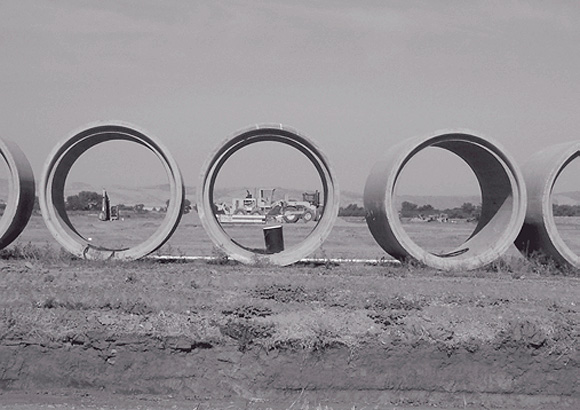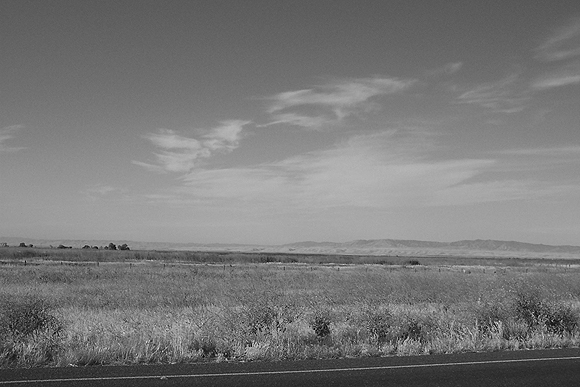The Golden State
It is difficult enough to understand California as an economic and cultural phenomenon if you have grown up here. For those who haven’t—those whose exposure to and understanding of the state is derived from movies and the news media—the Golden State appears as a wonderful but really weird place, defined by movie star politicians, great universities, cultural amenities, professional sports, screwball politics, informality, diversity, The Industry (entertainment), earthquakes, good weather, eclectic cuisine, and surfing. The elusive—perhaps mythical—“California lifestyle,” packaged as post-war modernity and romanticized by the Case Study House Program, has created a thin, Hollywood image, which, even today, California architects, movie producers, and fashion designers vainly pursue as a cultural mandate.
In fact, depending on what one is trying to accomplish in life (raise a family, start a business, go to school, become a citizen, retire, etc.), the state is either the land of opportunity or the land of obstruction. From a vantage point within the central San Joaquin Valley, the California lifestyle is a work in progress. It is being continually redefined, as hordes of refugees from all over the western states and other parts of California mix with refugees from other countries and cultures in California’s heartland. No one is quite sure what the San Joaquin Valley will look like—quantitatively or qualitatively—in twenty years, but there will certainly be more people living here, and housing will be the most significant piece in the livability puzzle.

The San Joaquin Valley of the Future
The present trajectory of the San Joaquin Valley finds the communities of this region heading toward a bleak future. Without a healthy environment, accessible and affordable quality education, and job opportunities for people of every socio-economic level, the San Joaquin Valley of the future will become an environmental and societal problem that all taxpayers in California will have to fix.
The development of the San Joaquin Valley is at a critical juncture historically. The cities of the Valley are beginning to articulate a regional vision for the Valley’s future that heads off the juggernaut of continued low-density sprawl at the expense of food production and environmental quality. As the most significant food-producing region in the world, population growth and food production have traditionally been at odds here. Visionary growers and food processors are now embracing precision farming practices that will create higher paying jobs and have less impact on the environment. Cities all over the Valley are rediscovering their downtowns. Higher housing densities and mixed-use developments are being encouraged where they were opposed not too long ago. These and other trends are beginning to shape a preferred future for the Valley that speaks of livable, sustainable, and affordable communities that provide a high standard of living and harmonious coexistence with precision farming operations.
Housing
One fact that Californians—architects included—often forget is that there is nothing homogeneous about this state. As designers of the built environment, we tend to follow trends established in the highly populated metropolitan areas, forgetting that California remains largely rural. The needs of rural California stand in stark contrast to the needs of San Francisco, San Jose, Los Angeles, or San Diego, but there is a common thread: housing.
Fluctuations in both macro- and micro-economic cycles initiate a ripple effect on the state’s economy. The state-wide housing market is susceptible to these economic fluctuations, which can affect both renters and owners. In a 2004 report published by the Public Policy Institute of California, entitled In Short Supply?: Cycles and Trends in California Housing, authors Hans Johnson, Rosa Moller, and Michael Dardia note the following:
- There is evidence of a shortage of approximately 138,000 housing units statewide.
- Almost all of the housing shortage originates in the Bay Area, Los Angeles, and San Diego, the state’s most populated regions.
- A slowdown in housing production coincided with a slowdown in population growth that occurred in the 1990s.
- Population growth in the 1990s featured a disproportionately large composition of children and immigrants, both of which tend to consume less housing than other demographic groups. Children don’t start households, and immigrants tend to live in larger extended family households.
- The recession of the 1990s slowed construction in direct response to changes in the business cycle, interest rates, income, prices, and inflation.
The cost of housing and the supply of housing are the most important determinants in establishing the cost of living index, which is often viewed as an indicator of how livable a community may be. The housing market often drives social trends and new patterns of living in a local economy. A vivid example of the role that the cost and supply of housing can play in the growth of a community and the transformation of an entire region can be found in Los Banos, California.
Los Banos and the Home Ownership Urge
Los Banos lies in western Merced County, served by Highways 152 and 165 and Interstate 5. It is approximately sixty miles northwest of Fresno, northeast of Monterey, and southeast of San Jose. This is a rapidly growing community of families, many of whom are attracted to the city’s relatively low cost of living and affordable home prices. Census data indicate that between 1990 and 2000 alone, the city grew from 14,519 to 25,869 residents, a 78 percent population gain. Many of those moving to Los Banos are families headed by people who provide services to Bay Area communities, but who cannot afford to own a home in the community where they work.
The city and county have historically been family-oriented communities, but by 2000 Los Banos edged past the county in family households. A recent study of childcare facility needs, executed by Bay Area Economics (BAE) of Berkeley, indicated that over 80 percent of households in Los Banos are families, and almost 54 percent of those households have children. By comparison, only 69 percent of California households overall are families, and only 40 percent have children. The BAE study found that the city’s average household size of 3.33 persons per household exceeds both the county and the state average.
The study’s authors, Simon Alejandrino and Amber Evans, found that, “While Los Banos’s low cost of living has attracted many families to the area, workers must now face long commute times to employment centers such as the Bay Area and are away from home for a significant portion of the workday.” Statistics show that approximately one half (47 percent) of Los Banos residents who work outside the home leave before 7:00 a.m., while 36 percent of countywide workers and 30 percent of California workers do so. The median commute is 45 minutes (one way), and almost one in four workers travels over 90 minutes to work (24 percent). As of the 2000 census, households in Los Banos earned a median income of $43,690, compared to $47,493 for the state.
As a direct result of housing affordability and the relatively close proximity to higher paying jobs found, for example, in San Jose, a living pattern common in larger cities but new to Los Banos has emerged. Because of the 45- to 90-minute commute, children are dropped off at school before school begins. After school, children are on their own until parents return home. This situation has generated the need for more and better childcare, and the City of Los Banos is now addressing this issue. The BAE study found that, based on current growth projections, there is a need for 724 subsidized childcare center slots in Los Banos through 2007. Until the need is met, children and families have to cope with the ongoing struggle between owning a home and providing adequate and safe childcare.
The California Psyche and the Future of the Valley
What is causing Californians to move to Los Banos from parts of the state that are considered “more desirable” and spend the same amount of time (if not more) commuting? Perhaps there is something in the California psyche that simultaneously pushes us to be in motion and to be rooted in a home that we own. The Los Banos illustration is a reminder of the insatiable urge for homeownership that is fueling the transformation of rural California to suburban California. This seemingly inevitable transformation will exacerbate the further degradation of the San Joaquin Valley unless aggressive and informed planning policies and design guidelines are adopted and enforced both regionally and locally.
The challenge presented to designers, planners, developers, local jurisdictions, politicians, and farmers is to work together to resist the momentum imposed by the trajectory of the past and to work toward a preferred future. We must deflect the impending default future and move toward a vision that realizes clean air, clean water, affordable housing, quality education, support of precision agriculture, and job creation—a vision that will serve the complete cross section of Valley society. While this sounds like election year rhetoric, it is, unfortunately, the daunting challenge facing the “bread basket” of the eighth-strongest economy in the world.
Author Paul N. Halajian, AIA, is a principal of The Taylor Group Architects of Fresno, California. He holds a Masters Degree from UC Berkeley and is currently serving on the editorial board of arcCA. After working in the San Francisco office of EHDD Architects, he returned to the San Joaquin Valley to become actively involved in the urban and architectural transformation occurring in the region. His practice is currently working on a number of public libraries and university projects throughout the Valley as well as master plans for revitalization of downtown residential neighborhoods in Fresno.
Originally published 2nd quarter 2004 in arcCA 04.2, “Small Towns.”









